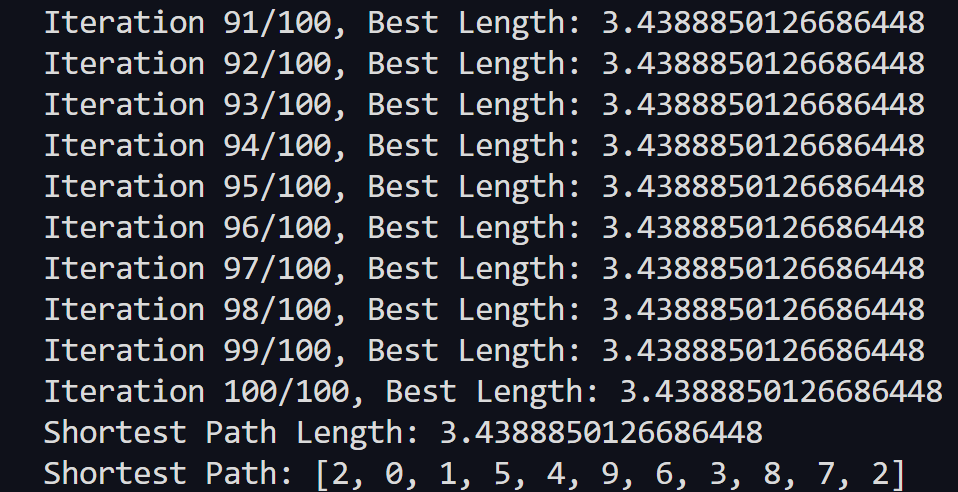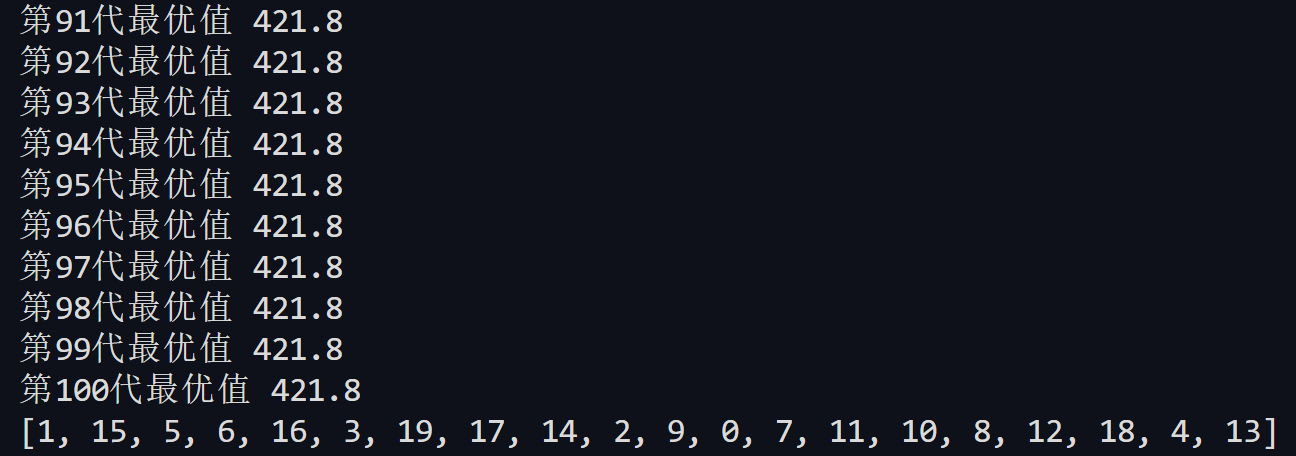1
2
3
4
5
6
7
8
9
10
11
12
13
14
15
16
17
18
19
20
21
22
23
24
25
26
27
28
29
30
31
32
33
34
35
36
37
38
39
40
41
42
43
44
45
46
47
48
49
50
51
52
53
54
55
56
57
58
59
60
61
62
63
64
65
66
67
68
69
70
71
72
73
74
75
76
77
78
79
80
81
82
83
84
85
86
87
88
89
90
91
92
93
94
95
96
97
98
99
100
101
102
103
104
105
106
107
108
109
110
111
112
113
114
115
116
117
118
119
120
121
122
123
124
125
126
127
128
129
130
131
132
133
134
135
136
137
138
139
140
141
142
143
144
145
146
147
148
149
150
151
152
153
154
155
156
157
158
159
160
161
162
163
164
165
166
167
168
169
170
171
172
173
174
175
176
177
178
179
180
181
182
183
184
185
186
187
188
189
190
191
192
193
194
195
196
197
|
import math
import random
import pandas as pd
import matplotlib.pyplot as plt
from matplotlib.pylab import mpl
mpl.rcParams['font.sans-serif'] = ['SimHei']
def calFitness(line, dis_matrix):
dis_sum = 0
dis = 0
for i in range(len(line)):
if i < len(line) - 1:
dis = dis_matrix.loc[line[i], line[i + 1]]
dis_sum = dis_sum + dis
else:
dis = dis_matrix.loc[line[i], line[0]]
dis_sum = dis_sum + dis
return round(dis_sum, 1)
def tournament_select(pops, popsize, fits, tournament_size):
new_pops, new_fits = [], []
while len(new_pops) < len(pops):
tournament_list = random.sample(range(0, popsize), tournament_size)
tournament_fit = [fits[i] for i in tournament_list]
tournament_df = pd.DataFrame \
([tournament_list, tournament_fit]).transpose().sort_values(by=1).reset_index(drop=True)
fit = tournament_df.iloc[0, 1]
pop = pops[int(tournament_df.iloc[0, 0])]
new_pops.append(pop)
new_fits.append(fit)
return new_pops, new_fits
def crossover(popsize, parent1_pops, parent2_pops, pc):
child_pops = []
for i in range(popsize):
child = [None] * len(parent1_pops[i])
parent1 = parent1_pops[i]
parent2 = parent2_pops[i]
if random.random() >= pc:
child = parent1.copy()
random.shuffle(child)
else:
start_pos = random.randint(0, len(parent1) - 1)
end_pos = random.randint(0, len(parent1) - 1)
if start_pos > end_pos:
tem_pop = start_pos
start_pos = end_pos
end_pos = tem_pop
child[start_pos:end_pos + 1] = parent1[start_pos:end_pos + 1].copy()
list1 = list(range(end_pos + 1, len(parent2)))
list2 = list(range(0, start_pos))
list_index = list1 + list2
j = -1
for i in list_index:
for j in range(j + 1, len(parent2)):
if parent2[j] not in child:
child[i] = parent2[j]
break
child_pops.append(child)
return child_pops
def mutate(pops, pm):
pops_mutate = []
for i in range(len(pops)):
pop = pops[i].copy()
t = random.randint(1, 5)
count = 0
while count < t:
if random.random() < pm:
mut_pos1 = random.randint(0, len(pop) - 1)
mut_pos2 = random.randint(0, len(pop) - 1)
if mut_pos1 != mut_pos2:
tem = pop[mut_pos1]
pop[mut_pos1] = pop[mut_pos2]
pop[mut_pos2] = tem
pops_mutate.append(pop)
count += 1
return pops_mutate
def draw_path(line, CityCoordinates):
x, y = [], []
for i in line:
Coordinate = CityCoordinates[i]
x.append(Coordinate[0])
y.append(Coordinate[1])
x.append(x[0])
y.append(y[0])
plt.plot(x, y, 'r-', color='#FF3030', alpha=0.8, linewidth=2.2)
plt.xlabel('x')
plt.ylabel('y')
plt.show()
if __name__ == '__main__':
CityNum = 20
MinCoordinate = 0
MaxCoordinate = 101
generation = 100
popsize = 100
tournament_size = 5
pc = 0.95
pm = 0.1
CityCoordinates = \
[(random.randint(MinCoordinate, MaxCoordinate), random.randint(MinCoordinate, MaxCoordinate)) for
i in range(CityNum)]
dis_matrix = \
pd.DataFrame(data=None, columns=range(len(CityCoordinates)), index=range(len(CityCoordinates)))
for i in range(len(CityCoordinates)):
xi, yi = CityCoordinates[i][0], CityCoordinates[i][1]
for j in range(len(CityCoordinates)):
xj, yj = CityCoordinates[j][0], CityCoordinates[j][1]
dis_matrix.iloc[i, j] = round(math.sqrt((xi - xj) ** 2 + (yi - yj) ** 2), 2)
iteration = 0
pops = \
[random.sample([i for i in list(range(len(CityCoordinates)))], len(CityCoordinates)) for
j in range(popsize)]
draw_path(pops[i], CityCoordinates)
fits = [None] * popsize
for i in range(popsize):
fits[i] = calFitness(pops[i], dis_matrix)
best_fit = min(fits)
best_pop = pops[fits.index(best_fit)]
print('初代最优值 %.1f' % (best_fit))
best_fit_list = []
best_fit_list.append(best_fit)
while iteration <= generation:
pop1, fits1 = tournament_select(pops, popsize, fits, tournament_size)
pop2, fits2 = tournament_select(pops, popsize, fits, tournament_size)
child_pops = crossover(popsize, pop1, pop2, pc)
child_pops = mutate(child_pops, pm)
child_fits = [None] * popsize
for i in range(popsize):
child_fits[i] = calFitness(child_pops[i], dis_matrix)
for i in range(popsize):
if fits[i] > child_fits[i]:
fits[i] = child_fits[i]
pops[i] = child_pops[i]
if best_fit > min(fits):
best_fit = min(fits)
best_pop = pops[fits.index(best_fit)]
best_fit_list.append(best_fit)
print('第%d代最优值 %.1f' % (iteration, best_fit))
iteration += 1
print(best_pop)
draw_path(best_pop, CityCoordinates)
|




